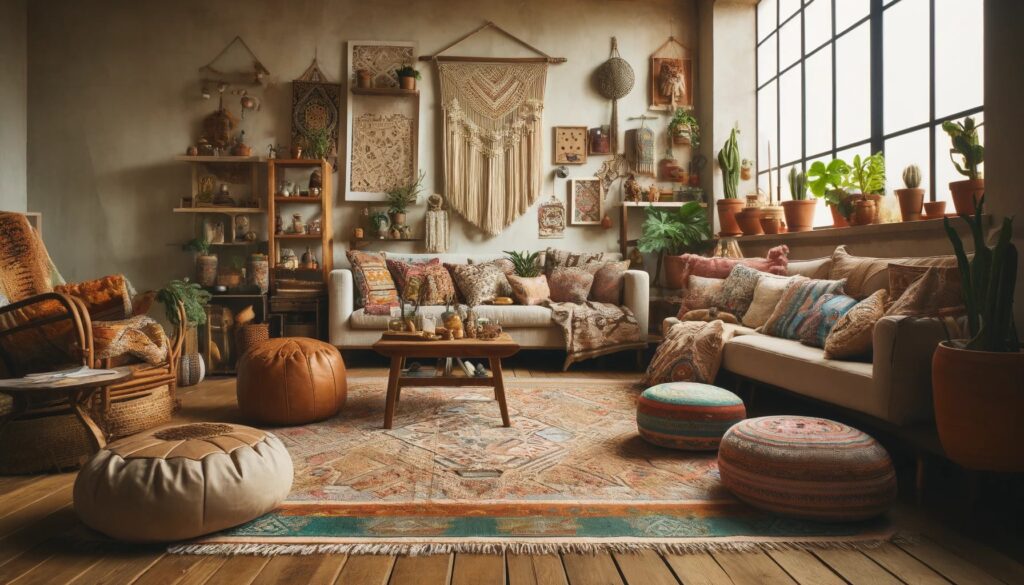Introduction
Definition of Bohemian Decor
Bohemian decor, often referred to as “boho” style, is a vibrant and eclectic approach to interior design. Characterized by its use of rich colors, diverse patterns, and a mix of various cultural influences, bohemian decor emphasizes a free-spirited and artistic lifestyle. Unlike minimalist or contemporary designs, boho decor thrives on its layered and lived-in feel, making every space unique and personal.
Importance and Appeal of Bohemian Decor in Modern Interior Design
In today’s world, where many seek individuality and expression in their living spaces, bohemian decor has gained immense popularity. Its flexibility and adaptability allow homeowners to infuse their personal style into every corner of their homes. The appeal lies in its ability to create warm, inviting, and visually stimulating environments that break away from conventional design rules.
Historical Context
Origins of Bohemian Decor
Bohemian decor traces its roots back to the Bohemian lifestyle of the 19th century, characterized by artists, writers, and free spirits who lived unconventional lives. The term “bohemian” was initially used to describe the nomadic Romani people, mistakenly thought to have come from the Bohemia region in the Czech Republic. This lifestyle embraced creativity, individuality, and a disregard for social norms, which eventually translated into a unique and eclectic interior design style.
Evolution of Bohemian Style Over the Decades
Throughout the 20th century, bohemian decor evolved, influenced by various cultural and artistic movements. The 1960s and 1970s saw a resurgence of boho style, with the hippie movement embracing its free-spirited and unconventional aesthetics. Today, bohemian decor continues to evolve, incorporating modern elements while staying true to its roots of individuality and artistic expression.
Key Principles
Eclectic Mix of Styles
A hallmark of bohemian decor is its eclectic mix of styles. This approach allows for the combination of various design elements from different eras and cultures, creating a unique and personalized space. The key is to blend these elements harmoniously, ensuring that the overall look remains cohesive despite the diversity.
Emphasis on Natural Elements
Bohemian decor heavily emphasizes the use of natural elements. Materials like wood, rattan, and wicker are commonly used to bring a touch of nature indoors. Additionally, plants play a significant role, not only adding greenery but also enhancing the organic feel of the space.
Vibrant Colors and Patterns
One of the most striking aspects of bohemian decor is its use of vibrant colors and patterns. Rich jewel tones like deep purples, emerald greens, and ruby reds are often paired with intricate patterns such as paisley, tribal prints, and florals. This bold use of color and pattern creates a lively and dynamic atmosphere.
Use of Vintage and Handmade Items
Incorporating vintage and handmade items is essential in achieving an authentic bohemian look. These pieces add character and history to the space, making it feel curated and unique. Thrift stores, flea markets, and artisan shops are excellent places to find such treasures.
Methodologies and Tools
How to Mix and Match Styles
Successfully mixing and matching styles in bohemian decor involves balancing contrast and cohesion. Start by choosing a dominant style or theme, and then introduce complementary elements. For instance, a mid-century modern sofa can be paired with Moroccan-inspired rugs and vintage accessories to create a cohesive yet eclectic look.
Selecting Natural Materials
When selecting natural materials for a bohemian interior, prioritize sustainability and authenticity. Opt for reclaimed wood, organic textiles, and eco-friendly finishes. Natural materials not only enhance the aesthetic but also contribute to a healthier living environment.
Incorporating Patterns and Textures
Incorporating patterns and textures is key to creating depth and interest in bohemian decor. Layering different patterns, such as mixing geometric prints with floral designs, can create a visually rich environment. Similarly, combining various textures like smooth silk, rough jute, and soft velvet adds tactile diversity.
Choosing Vintage and Handmade Items
Selecting vintage and handmade items involves patience and a keen eye for quality. Look for pieces that tell a story, whether it’s an antique mirror with intricate detailing or a handmade ceramic vase. These items should feel authentic and resonate with your personal style.
Case Studies
Successful Bohemian Decor Projects
Several successful bohemian decor projects showcase the versatility and beauty of this style. For example, the home of interior designer Justina Blakeney, founder of The Jungalow, exemplifies how boho decor can be both stylish and functional. Her spaces are filled with lush greenery, bold patterns, and a mix of vintage and modern pieces, creating a vibrant and welcoming home.
Celebrity Homes Featuring Bohemian Decor
Celebrity homes often serve as inspiration for bohemian decor enthusiasts. For instance, actress and singer Zooey Deschanel’s home is a perfect example of boho chic. Her space features an eclectic mix of vintage furniture, colorful textiles, and personal mementos, reflecting her quirky and artistic personality.
Influential Bohemian Designers
Influential designers like Justina Blakeney and Amber Lewis have made significant contributions to the popularity of bohemian decor. Their unique approaches to design emphasize comfort, creativity, and a deep connection to nature, inspiring countless homeowners to adopt the boho style.
Challenges and Solutions
Balancing Eclectic Elements
One of the main challenges in bohemian decor is balancing the eclectic elements to avoid a chaotic look. The solution lies in finding a unifying theme or color palette that ties the different pieces together. Using neutral backdrops can also help to ground the vibrant patterns and colors.
Sourcing Vintage and Handmade Items
Sourcing vintage and handmade items can be time-consuming and requires dedication. However, online marketplaces like Etsy and local flea markets are excellent resources. Building relationships with local artisans and vendors can also provide access to unique and high-quality pieces.
Creating a Cohesive Look
Achieving a cohesive look in a bohemian space involves careful curation and thoughtful placement of items. Avoid overcrowding by choosing a few standout pieces and allowing them to shine. Regularly editing and rearranging the space can help maintain a balanced and harmonious look.
Future Trends
Emerging Bohemian Decor Trends
Emerging trends in bohemian decor include a focus on sustainability and eco-friendly practices. More homeowners are seeking out ethically sourced materials and upcycled furniture. Additionally, there is a growing interest in blending boho style with other design aesthetics, such as Scandinavian minimalism, to create a more refined and modern look.
Sustainable Bohemian Decor Practices
Sustainable practices in bohemian decor involve choosing environmentally friendly materials and supporting artisans who use traditional and sustainable methods. This includes using organic fabrics, low-VOC paints, and furniture made from reclaimed or responsibly sourced wood.
Expert Opinions
Interviews with Interior Designers
Interior designers specializing in bohemian decor emphasize the importance of personalization and authenticity. According to Justina Blakeney, “Bohemian decor is all about creating spaces that reflect your personality and tell your story. Don’t be afraid to mix and match and let your creativity shine.”
Advice from Bohemian Style Influencers
Bohemian style influencers often share practical advice for achieving the perfect boho look. Amber Lewis, a prominent boho designer, suggests, “Start with a neutral base and layer in bold colors and textures. Don’t be afraid to mix different eras and styles—boho is all about the unexpected.”
Resources for Learning
Books on Bohemian Interior Design
Books like “The New Bohemians: Cool and Collected Homes” by Justina Blakeney and “Bohemian Modern: Imaginative and Affordable Ideas for a Creative and Beautiful Home” by Emily Henson offer a wealth of inspiration and practical tips for creating bohemian interiors.
Online Courses and Tutorials
Online platforms like Skillshare and Udemy offer courses on bohemian interior design, covering everything from color theory to furniture selection. These courses provide step-by-step guidance and professional insights.
Blogs and Websites for Inspiration
Blogs like The Jungalow and websites like Apartment Therapy regularly feature bohemian decor ideas and inspiration. These resources offer practical advice, DIY projects, and stunning examples of boho interiors.
Conclusion
Summary of Key Points
Bohemian decor is a vibrant and eclectic style that emphasizes individuality, creativity, and a deep connection to nature. Its rich history, key principles, and modern adaptations make it a popular choice for homeowners seeking a unique and personal touch in their interiors.
Future Outlook for Bohemian Decor
The future of bohemian decor looks promising, with emerging trends focusing on sustainability and the blending of different design aesthetics. As more people seek out personalized and meaningful living spaces, boho style will continue to evolve and inspire.

